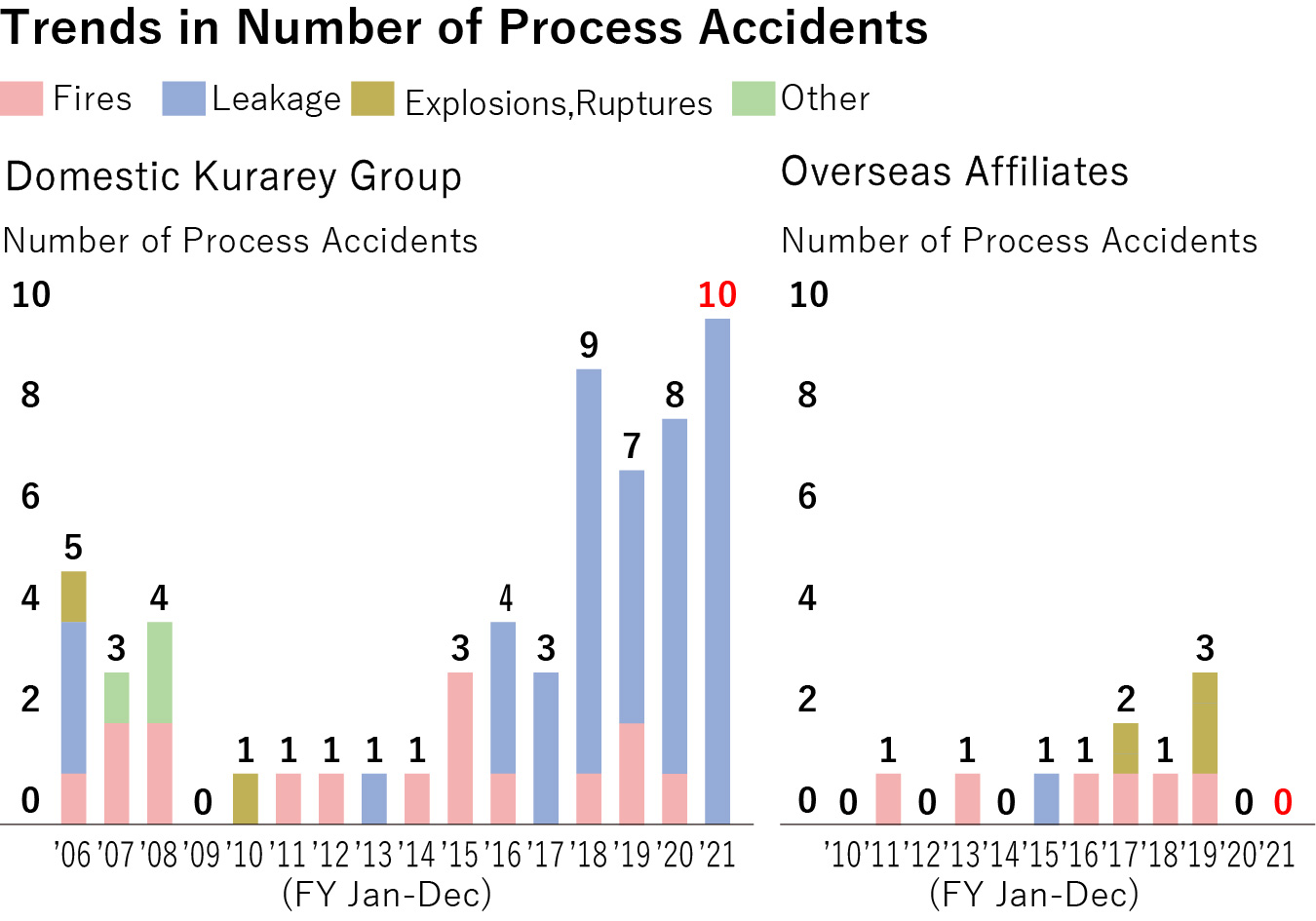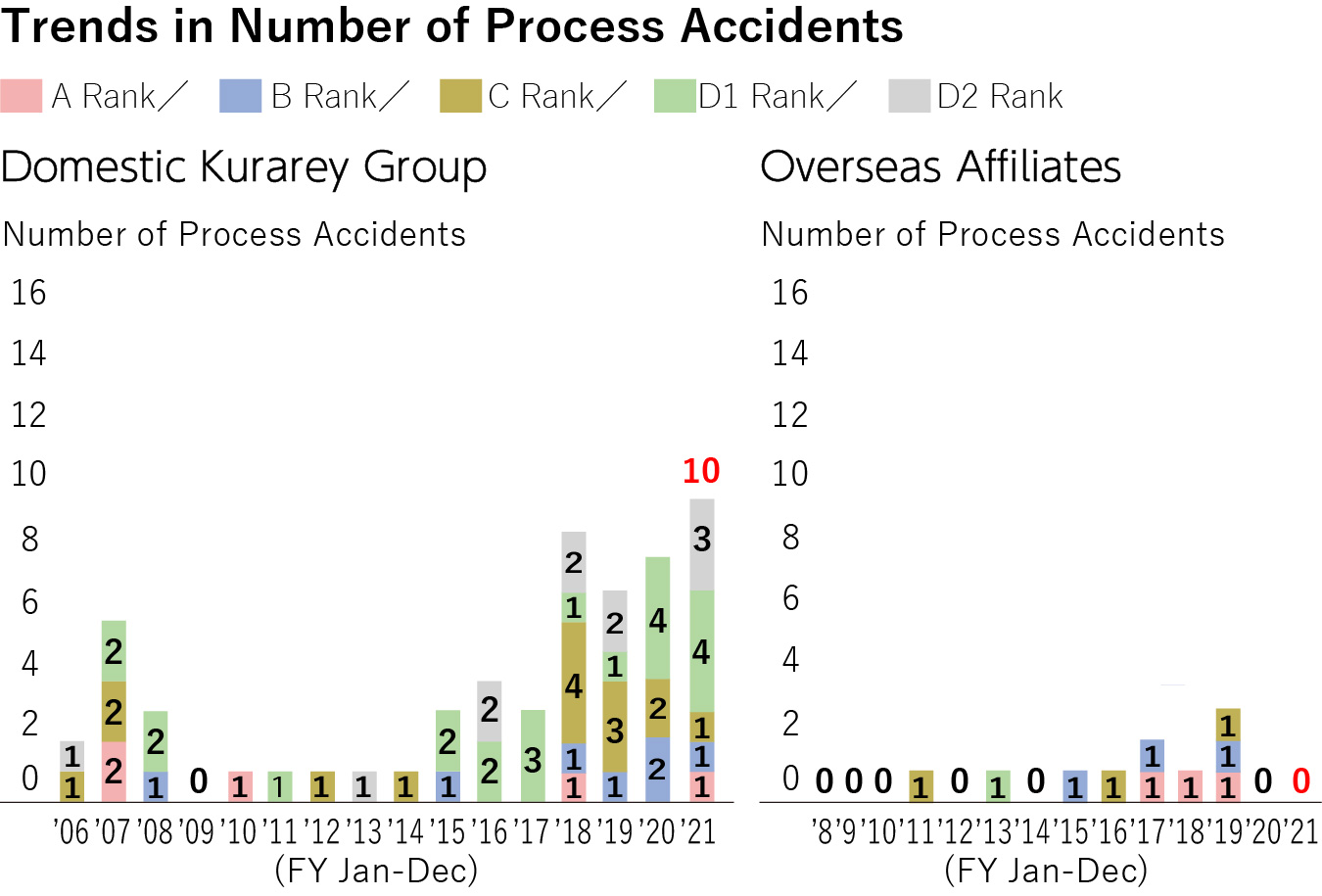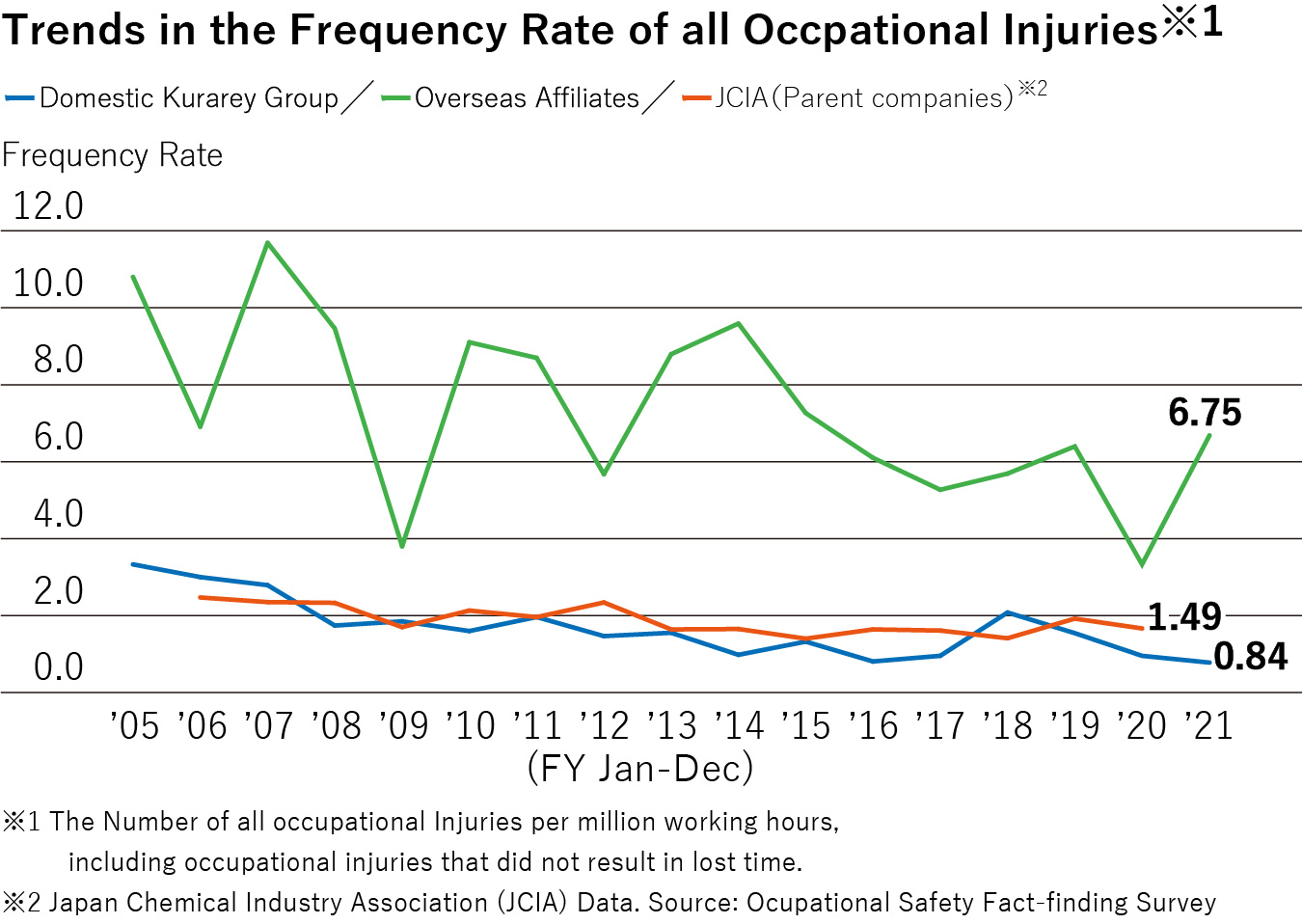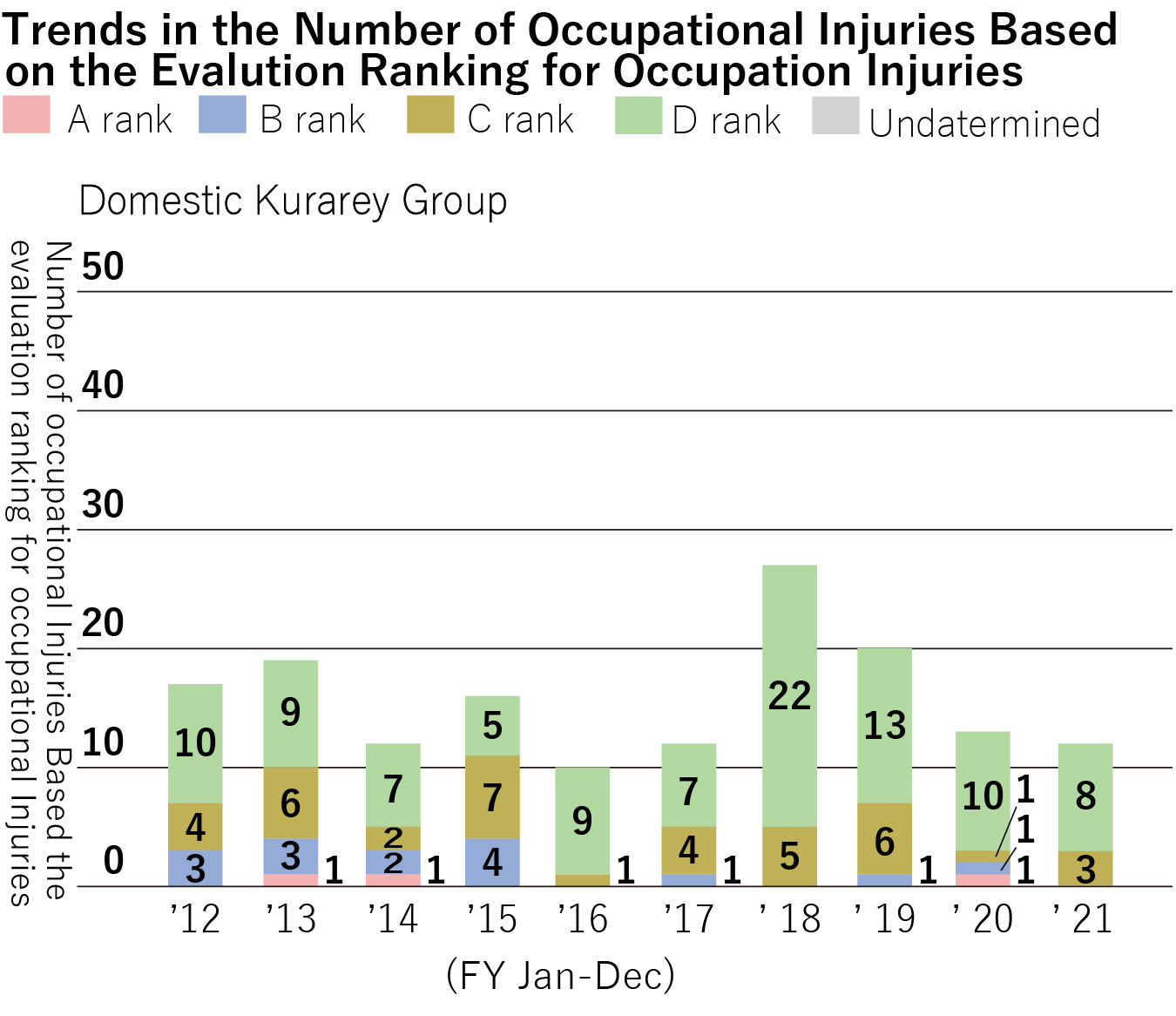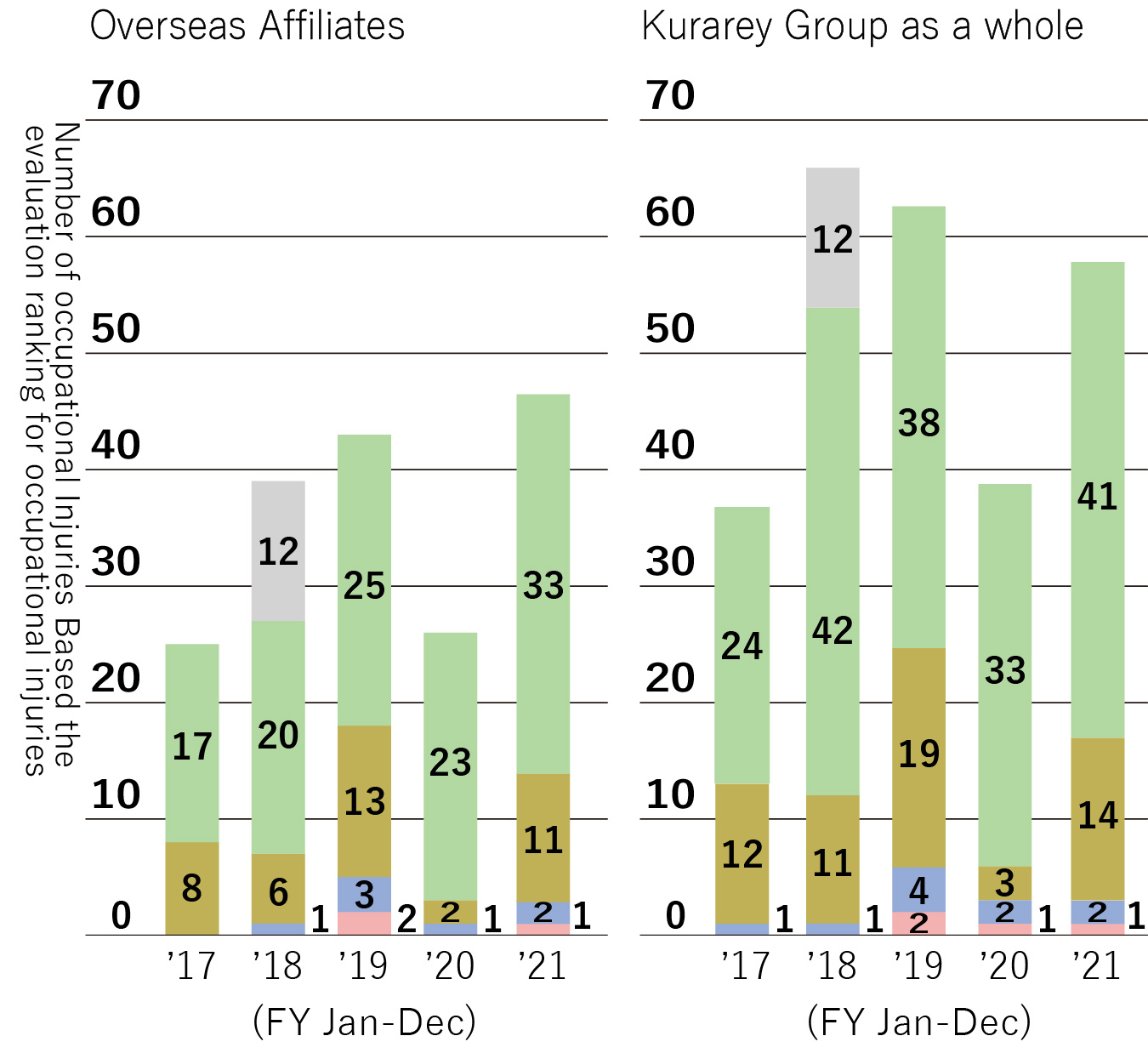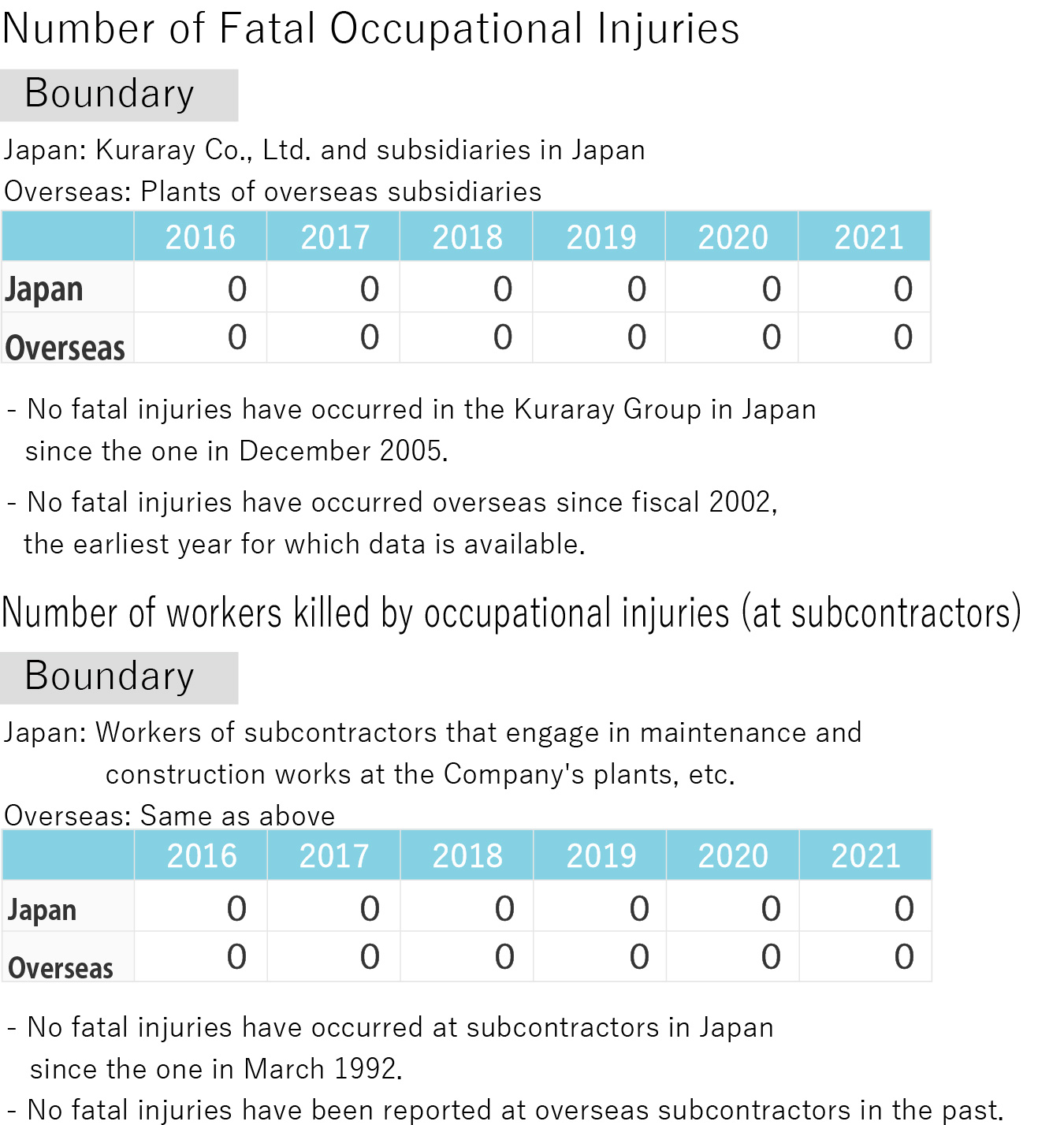
Kuraray’s Approach to Safety
For the Kuraray Group’s business activities, safety is an absolute necessity, and the cornerstone of everything we do. Building “Trustful workplaces and a safe and accident-free company” is a key theme required for maintaining stable product supply and trustworthiness for society.
With these concepts in mind, the Kuraray Group has established and implemented a safety management system to undertake various activities. A number of initiatives are being promoted to raise the safety awareness of our employees and to have safety behavior and confirmations established as common practice at work.
Each worksite tries to find process safety risks and occupational risks through risk assessment activities, and to prevent the occurrence by promoting inherent safe measures for facilities. In preparation for process accidents or occupational injuries, we make efforts to prevent the recurrence of process accidents or occupational injuries, in ways such as by holding emergency drills to minimize the damage and sharing information on the accident or lessons learned, or by disseminating information regarding measures across the company.
- Guiding Principle for Ensuring Safety
- Safety is the
Cornerstone of
Everything We Do
- Action Courses for Ensuring Safety (FY2022)
- Ensuring "Safety First, Production (Construction and R&D) Second"
- Predict Hazards and Make Sure the Safety before Taking Action, then Confirm the Action Results are What You Expected
- Each Employee Acts with the Intention of Ensuring Safety as “Their Own Issue”
Safety Activity Management
In accordance with the Company's Safety Activity Management Regulations, the Kuraray Group develops a safety plan every fiscal year and implements it to ensure occupational safety and process safety. To be more specific, at the Safety Promotion Committee attended by the President and executives in charge, we make an overall assessment and have a discussion on safety activity performances of the current fiscal year and establish an activity policy for the coming fiscal year. This policy is reflected in and implemented through specific action plans of each plant and department. A group of safety representatives from headquarters, including executives in charge of safety, visit every plant of the Group in Japan twice a year to examine their activity plans, the management of implementation progress, and the results. In addition, staff members from headquarters visit the Group subsidiaries outside Japan once every three years to confirm their statuses. * We perform an overall assessment on results based on the challenges found through the surveys made at each plant, the safety results for that year, and other factors. We incorporate this assessment into the formulation of company-wide policies for the next year, thereby operating a management system for safe operations.
*In fiscal 2020 and 2021, the verification of safety activities was conducted via web meeting remotely due to the COVID-19 situation.
Results
| FY2021 | ||
| Indicator for evaluation | Actual results | |
| Process safety | A, B, and C rank accidents:*1 Zero | 3 cases |
|---|---|---|
| D1 and D2 rank accidents:*1 3 or less | 7 cases | |
| Occupational safety | A and B rank injuries:*2 Zero | 3 cases |
| The frequency rate of all occupational injuries:*3 1.5 or less | 2.89 | |
*1 An evaluation ranking of process accidents using Kuraray's proprietary system. Five ranks from the most serious evaluation: A > B > C > D1 > D2.
*2 An evaluation ranking of occupational injuries using Kuraray's proprietary system. Four ranks from the most serious evaluation: A > B > C > D.
*3 The frequency rate of all occupational injuries: The number of all occupational injuries per million working hours, including occupational injuries that did not result in lost time.
Process Safety
At the Kuraray Group, we consider it our major responsibility to prevent the occurrence of explosions or fires, leakage of hazardous materials and other accidents that could have an immense impact on society, as well as to minimize any damage in the event of such occurrence. For this purpose, we have continuously undertaken activities such as risk assessment related to process safety, and strive to take earthquake and tsunami countermeasures for buildings and plants, and organize the safety management system for facilities.
After accidents occurred at another company in the 2010s, we paid particular attention to the risk assessment of unusual tasks and situations such as the starting and ceasing of an operation, a power and water outage, and an emergency shut-down. Moreover, we also extract various risks that may arise in the event of a failure of safety equipment or incompliance with standard procedures or rules, and consider countermeasures.
Additionally, we develop ideas and human resources that can promptly respond to an unusual situation before an accident occurs through implementing education to raise the members’ sensitivity to risks and clarify standards to determine an unusual situation, so that they can detect any sign of abnormalities.
Employees are regularly trained through on-site drills on various situations including the night time, holidays, when managerial personnel are absent and situations that occur without notice, in a drill using an external facility or a joint drill with a local fire department.
We are engaging in initiatives for receiving evaluations from an external organization about our safety-related foundations and culture, and we aim to be a safe company that does not suffer any accidents by operating the PDCA cycle with a thorough understanding of which areas need further reinforcement.
In the event of a significant accident, an Emergency Command Center led by President is ready to be established to promptly respond to the situation and provide on-site support. Media training is also provided to key managerial personnel in charge of public relations to enable them to appropriately provide information to the regional community and media in case of such an accident.
There were no process accidents in the Group overseas in fiscal 2021, but there were 10 leakage accidents of hazardous materials or freon gas in the Kuraray Group in Japan. Three cases were relatively serious (A, B, and C rank) process accidents, for which our target is zero cases, and seven cases were minor (D1 and D2 rank, e.g., a very small amount of hazardous materials leaked), for which our target is 3 or less cases. We will continue to promote risk identification and countermeasures to aim for zero major process accidents and to reduce the number of minor process accidents.
In addition to continuing the safety audits that began at these plants in fiscal 2019, we also introduced a new global process safety management framework and are implementing thorough measures to prevent recurrence of accidents and addressing issues brought to light by the audits.
Occupational Safety
Realizing that the safety and health of its employees are the basis of business activities, the Kuraray Group aims to create safe and injure free workplaces by striving to enhance the safety level of each of its employees and organizations. It does this through appropriately implementing its safety activity management system.
Through Group-wide policies and activity items including Guiding Principles and Action Courses for Ensuring Safety, policies and plans are thoughtfully developed and put into practice according to each plant’s and division’s situations and their unique ideas. Safety activities and their challenges are discussed among workers and employers at the Safety and Health Committee held by each of the domestic plants and factories every month, aiming to realize workplaces where people can safely work at ease without accidents.
Through risk assessment activities and inherent equipment safety measures, activities to reduce equipment-caused injuries have successfully decreased serious occupational injuries. However, many occupational injuries caused by individuals’ unconsidered or unconscious behavior have still occurred. Therefore, education to raise the sensitivity of each employee to risks has been promoted to eliminate such occupational injuries.
In fiscal 2021, the frequency rate for all occupational injuries within the entire Group was 2.89 (0.84 in the Group in Japan and 6.75 in the Group outside Japan), which failed to meet the target (which was 1.5 or less in the entire Group). The number of occupational injuries decreased in Japan for the third year in a row, but significantly increased overseas. Kuraray has introduced an evaluation system to rank the seriousness of occupational injuries on a scale of one to four, from A to D. We have set a goal of zero for A and B rank serious injuries. In fiscal 2021, the total number of A and B rank injuries in the entire Group was three (zero in Japan; one A rank case and two B rank cases overseas). Our target was therefore not achieved. The A rank case was an injury involving entrapment in a rotating machine. The B rank cases were caused by contact with a conveyor belt and by a heavy object that fell. We will improve our facilities and strengthen management to eliminate such serious occupational injuries.
In addition, although the number is on a downward trend in Japan, numerous occupational injuries caused by individuals’ unconsidered or unconscious behavior, such as slipping or falling, have occurred in the Kuraray Group overseas and we are continuing our efforts to reduce such “behavioral injuries.” As many occupational injuries involved inexperienced workers, we will continue to review and enhance the new employee training. We will continue to firmly proceed with our efforts to address these issues, and going forward, we will strive to fulfill the objective of achieving a safe workplace where occupational injuries do not occur.
Risk assessment of new business, capital investment, etc.
The Kuraray Group has in place and operates a system that carries out prior surveys and risk assessment regarding process safety and occupational safety and health of new projects and capital investments in and outside Japan through the functions of the Technical Evaluation Committee, the Technology Review Meeting and the Safety and Environment Examination to verify that safety measures and environment measures are sufficiently considered before moving to the next step. In addition, changes in raw materials, facilities, operating conditions and the organization as well as personnel transfer in line with the organizational change (supervisors, administrators, persons in charge, etc.) are implemented after taking measures required upon assessing risks as part of the change control process. The Kuraray Group ensures safety in introducing new business and facilities by steadily implementing these initiatives.
Safety Audits for Chemical Plants outside Japan
We initiated safety audits for chemical plants outside Japan in fiscal 2019 and we have continued to grasp process safety risks and review and strengthen safety measures to ensure the safety and stable operation of the Group outside Japan. In fiscal 2021, we conducted on-site audits at two plants in the United States and remote audits at one plant in the United States and one in Asia. In the fiscal 2021 safety audits, we checked the status of responses to issues identified in the previous year. We also identified new issues including thorough cause analysis of process accidents and trouble and progress management of safety measures to completion. In fiscal 2022, in addition to the Japan-based team that has conducted audits until this year, we are planning to form an in-house team of global process safety management experts to audit chemical plants outside Japan. Horizontal audits by this team will give us a better grasp of the process safety management level of each production site and enable us to take appropriate countermeasures.
Kuraray’s Proprietary Evaluation Method for Process Accidents
Up to now, the Kuraray Group set targets for process accidents by evaluating safety performance based on the number of accidents, regardless of their severity. However, this method was insufficient for setting the appropriate targets according to risk. Accordingly, we tried to classify process accidents according to their size and include them in the evaluation rank. However, most of the process accidents that occurred within the Kuraray Group were classified as the lowest rank according to the generally used classification method (the CCPS method, etc.), which did not meet our objectives. In 2020, therefore, we developed a proprietary evaluation method. This evaluation method classifies the scale of an accident by the type of accident (fire, explosion, leakage, etc.), and determines rank by taking into account the presence or absence of human damage and factors that led to the occurrence of the accident, etc.. The method also enables further sorting and classification of accidents with the lowest rank in the CCPS classification. In this way, we aim to eliminate major accidents that fall into the A, B, or C rank as “accidents that should never occur.” For minor accidents classified as D1 or D2 rank (slight leakage of hazardous materials, a small fire that is extinguished immediately, etc.), we set targets for each type of “accident that requires a reduction in the frequency of occurrence of risk,” and use these targets to carry out appropriate safety risk reduction activities in accordance with risk. From fiscal 2021, we have set annual targets for security and disaster prevention based on this evaluation method and are implementing measures accordingly.
Evaluation and Classification of Occupational Injuries
Generally, categories based on the severity of actual injuries, including fatal injuries, lost time injuries and non-lost time injuries, are used as an indicator for occupational injuries. In particular, the frequency rate of lost time injuries is often used to assess the level of or establish a target for organizational safety.
However, actual safety levels may deviate from the results of this assessment method for the following reasons:
- (1) The severity of injuries is unpredictable in many cases.
- (2) The occurrence factors of an injuries are not taken into consideration.
- (3) (When it is applied to global management) criteria of determining the degree of injuries depends on the country.
In 2012, we therefore have established a proprietary evaluation and classification of occupational injuries by subtracting unpredictable factors and adding an assessment of occurrence factors. This quantifies not the actual severity of injuries but the potential severity of injuries that could have been caused by an occupational injuries. Moreover, faults that caused such injuries are divided into human, equipment and managerial, rated numerically, and added to the potential severity of injury to determine the ranking from A, B, C to D.
As a result, the number of severe occupational injuries ranked A and B serves as an indicator for evaluating the level of organizational safety.
